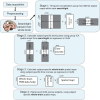Echoes of the brain within default mode, association, and heteromodal cortices
- PMID: 23986239
- PMCID: PMC3810536
- DOI: 10.1523/JNEUROSCI.0570-13.2013
Echoes of the brain within default mode, association, and heteromodal cortices
Abstract
Intrinsic connectivity networks (ICNs), such as the default mode, frontoparietal control, and salience networks, provide a useful large-scale description of the functional architecture of the brain. Although ICNs are functionally specialized, the information that they process needs to be integrated for coherent cognition, perception, and behavior. A region capable of performing this integration might be expected to contain traces, or "echoes," of the neural signals from multiple ICNs. Here, using fMRI in humans, we show the existence of specific "transmodal" regions containing echoes of multiple ICNs. These regions include core nodes of the default mode network, as well as multimodal association regions of the temporoparietal and temporo-occipito-parietal junction, right middle frontal gyrus, and dorsal anterior cingulate cortex. In contrast, "unimodal" regions such as the primary sensory and motor cortices show a much more singular pattern of activity, containing traces of few or even single ICNs. The presence of ICN echoes might explain how transmodal regions are involved in multiple different cognitive states. Our results suggest that these transmodal regions have a particular local spatial organization containing topographic maps that relate to multiple ICNs. This makes transmodal regions uniquely placed to be able to mediate the cross talk between the brain's functional networks through local modulation of adjacent regions that communicate with different ICNs.
Figures







Comment in
-
Functional integration of large-scale brain networks.J Neurosci. 2013 Nov 27;33(48):18710-1. doi: 10.1523/JNEUROSCI.4084-13.2013. J Neurosci. 2013. PMID: 24285877 Free PMC article. No abstract available.
References
-
- Beckmann CF, Mackay CE, Filippini N, Smith SM. Group comparison of resting-state FMRI data using multi-subject ICA and dual regression. Paper presented at 15th Annual Meeting of the Organization for Human Brain Mapping; June; San Francisco, CA. 2009.
Publication types
MeSH terms
Grants and funding
LinkOut - more resources
Full Text Sources
Other Literature Sources
